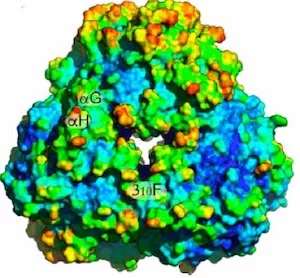
The structure, kinetics and interactions of the β-carboxysomal β-carbonic anhydrase, CcaA
Photosynthesis is the secret to all life, a secret discovered and closely guarded for over 3 billions years by an ancient group of tiny organisms. We are of course talking about the CYANOBACTERIA! Amazingly, PhD student Maryam Moazami-Goudarzi (Espie Lab) has uncovered and shared part of the secret ingredients cyanobacteria use to accomplish their amazing feat. Her results were recently published in her first 1st-authored paper, published in Biochemical Journal. Much of cyanobacteria’s success is due to concentrating CO2 within a proteinaceous microcompartment called a carboxysome. Maryam and her coauthors described the crystal structure, kinetics and protein-protein interactions of the β-carboxysomal β-carbonic anhydrase (CcaA - see figure), a key enzyme within the carboxysome. CcaA was found to have a unique hexameric, trimer-of-dimers organization, not previously observed in any other organism. The complex interactions between CccA and other proteins in the carboxysome appear to be important as a mechanisms for fine–tuning the concentration of CO2 necessary for photosynthesis.
Congratulations on this terrific work and your First Paper Award!
